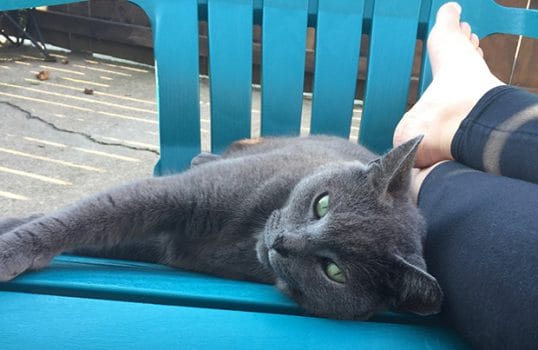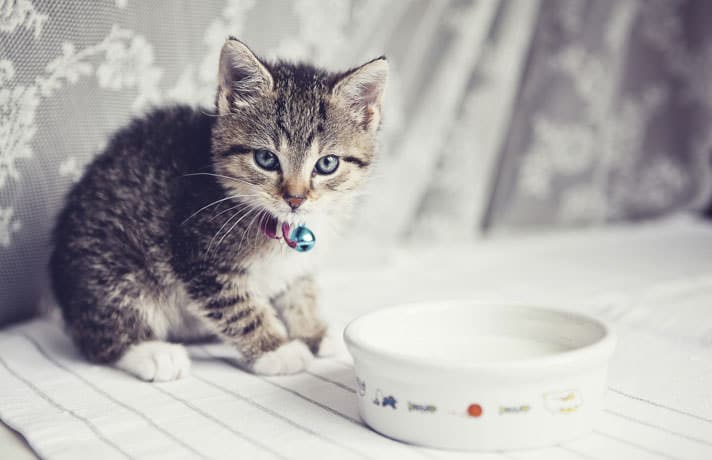When I moved to a new city three years ago with my husband and son, I had no intention of taking on new pets. Our two senior cats–affectionate, plump and occasionally cranky–were already a handful at times. We had adopted both of them from shelters when they were young and at their age, it seemed unreasonable to add a new pet to the mix.
What I didn’t know at the time was that cats often choose their people, not the other way around.
Shortly after moving in, I noticed a small, striped tabby cat hanging out near the back patio. Skinny and nervous, she devoured the food I set out, but darted away when I tried to pet her. I wondered if she might belong to a neighbor, but nobody claimed her, and after that first day, she started showing up for cat food on a regular basis.
Maybe she got left behind when someone moved, or got lost and couldn’t find her way home,I thought. One of her ears was missing the tip; instead of pointing up in a triangle, it ended in a neatly-shaped flat line. She must have gotten in a fight – poor thing. I kept feeding the cat and hoped that I could find her owners, but my search proved unsuccessful.
I started to get suspicious a couple of weeks later when two more cats appeared on the patio at dinnertime. One was a young, short-haired gray cat with scared-looking eyes who fled at the sound of heavy footsteps, the other was an older, bedraggled striped cat with long whiskers, whose ribs were visible beneath her dirty fur. Strangely enough, both of the new arrivals were also missing the tip of one ear, in the exact same spot.

After I determined that they didn’t belong to any of my neighbors, I contacted a local no-kill animal shelter to try to find homes for all three. I learned that the strange clipped ears I had noticed meant these cats were stray or feral. The volunteer informed me that some feral cats start out as lost pets, while others are born in the wild and never adjust to human contact.
Animal shelters simply can’t accommodate the large number of stray and feral cats in the US, so they’re humanely trapped, spayed or neutered and then returned to the location where they were found, where they form small colonies.
The volunteer told me, not unkindly, that cats like the ones I’d found on my patio are usually unadoptable. They never quite warm up to people in the way that most animals do, and they can be highly unpredictable, so they’re often written off in traditional shelters – many are even euthanized. She advised me that my best course of action would be to set out food and water, but not to expect much in return.
As a lifelong cat lover, I couldn’t give up on the strays that easily. There was something in their eyes that drew me in. Every time I saw the strays outside, huddling under parked cars or drinking water from puddles on the sidewalk, I thought of my own two pampered housecats, warm and safe inside. If circumstances were different, they could be the ones out there in the rain and cold fighting to survive.
[Feral cats] never quite warm up to people in the way that most animals do, and they can be highly unpredictable, so they’re often written off in traditional shelters – many are even euthanized.
I kept setting out food and water daily. Over time, the strays began to show up like clockwork for morning and evening meals and they started looking healthier and eating less frantically. When the weather turned cold, the cats huddled together in the corner of the patio, shivering beside the dryer vent, which provided pitifully little heat.
An attempt to bring them into the basement on one particularly chilly night proved unsuccessful; only one cat allowed herself to be picked up and she hid in the corner of the storage room all night, wide-eyed and terrified. When morning came, I put her back outside, where she immediately rubbed her head against my leg, purring to communicate her happiness at being back in familiar territory. Message received.
With the help of a tutorial I found online, I built three small shelters out of plastic storage containers and filled them with straw to keep the cats safe from the wind and snow. This was more successful than my failed attempt to domesticate the cats for the winter. In the afternoon, I’d look out my window to find all three curled in their boxes, napping peacefully despite the bitter cold.
By the spring, the cats had grown to trust and depend on me and my family. They spent their days napping on the patio in the sunshine. We went away for a few days on vacation, setting out plenty of food, and when we returned, the strays vied for our attention as hard as the indoor cats did. Clearly, the fondness I felt for these cats was mutual.

Stray and feral cats are often misunderstood or ignored. In order to appreciate their beauty, I had to get to know my strays on their own terms. These are no calm house cats. They’ll probably never be adoptable, just like the volunteer at the shelter told me.
Still, they show their affection in other ways. I can always count on them to run out and greet me when I come home, and they love to sleep under my patio chair when I’m outside relaxing.
Each cat has her own unique personality. One brings me “treats” to show her appreciation (birds, mice, and even a tiny bat), while another loves to roll on her back and show me her belly when she’s happy.
They look out for us, too. One night when I was outside, the cats started hissing and growling. Turns out a raccoon was trying to come on the patio and I hadn’t noticed until they alerted me.
By accepting these stray cats for what they are and not trying to force them into pet mode, I ended up with three unexpected feline friends. In turn, they’ve learned that humans aren’t so bad after all.

Jen Bryant is a writer, animal lover and stray cat whisperer. Her work has been featured in several local and national publications, including Ms., BUST, Hipmama and MUTHA Magazine.
Share:









